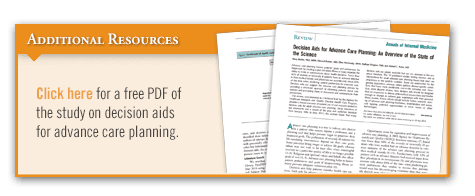With advance care planning, clinicians can help honor patient preferences and goals in cases of incapacitating illness or when injuries prevent adequate communication. These tools are designed to help prioritize treatment goals, but each person’s personal care goals will vary with regard to life-sustaining interventions. Some will prioritize living longer, whereas others may not wish to be kept alive when it is unlikely that they will have a meaningful recovery or better quality of life. Studies show that religious and spiritual values and beliefs may also affect goals of care. Research suggests that less than half of severely or terminally ill patients have advance directives in their medical record. Compounding the problem is that physicians are accurate only about 65% of the time when predicting patient preferences for intensive care.
Decision aids for advance care planning support three key components of the process: 1) learning about anticipated conditions and options for care; 2) considering these options; and 3) communicating preferences for future care. “The type of decision aid that will be most useful for decision makers depends on the patient’s current health status and the predictability of illness trajectories,” says Mary Butler, PhD, MBA (Figure). For example, healthy people may benefit most from general decision aids that focus on choice-of-healthcare proxies and goals of care for hypothetical situations. For patients with life-threatening illnesses, decision aids may focus on decisions to accept, withhold, or terminate specific treatments.
Analyzing Current Decision Aids
In a review published in Annals of Internal Medicine that was commissioned as a technical brief by the AHRQ Effective Health Care Program, Dr. Butler and colleagues provided an overview of advance care planning decision aids for adults. The study assessed publicly available decision aids for healthy people and for those with serious or advanced illnesses. “Assessing the current literature base on this topic gave us insight into the decision aids currently available as well as the types of decision aids most useful in specific situations and a sense of what is still needed,” Dr. Butler says.
The study team used literature searches, internet searches, and leads from seven key informants, which included practicing clinicians and attorneys involved in advance care planning, experts in medical law and medical ethics, consumer advocates, and decision aid researchers and developers. The group then separated decision aids into two categories. The first targeted a predominantly healthy audience, and the second targeted patients with life-limiting illnesses. In total, the team assessed eight decision aids for healthy individuals and 11 in the life-limiting illness category.
Dr. Butler and colleagues reviewed 16 published studies testing decision aids as interventions for adult advance care planning. They found that many decision aids are widely available but are not evaluated in the empirical literature. “Most of these aids are proprietary or not publicly available,” says Dr. Butler.
An overarching theme with decision aids was that much communication is needed in order to determine preferences and address patient expectations. “Patient–physician decision concordance is paramount, and there is no one-size-fits-all decision aid,” Dr. Butler says. The study noted that clinicians should rely on well-considered and well-communicated preferences to feel comfortable about the ethics of providing or withholding treatments that affect survival.
Considerations in Future Research
Several future research efforts could help improve advance care planning decision aids, according to Dr. Butler. “We need more decision aid tools that are well-designed and validated and are easily accessible, readable, understandable, and appropriate for patients across various settings,” she says. “To accomplish this goal, there needs to be better collaboration among stakeholders.” A wide range of decision tools may be necessary for use by various practitioners and in different settings and stages. The criteria for assessing decision aids should include how efficient they are to use in advance care planning, whether they effectively help individuals identify and communicate their preferences, and most importantly, whether patients’ preferences are accurately considered and reflected at the point of care.
According to Dr. Butler, computer- and internet-based decision aids may be helpful, but it is important to consider that these tools are sometimes unavailable to vulnerable populations. “Developing good decision aids is challenging because there are many accessibility factors to consider,” she says. “Not all patients have the ability to access computers or the internet. We also need to develop no-cost decision tools so that they can be used by all patients within the healthcare system. Unfortunately, there is a disconnect between the propriety creators and the public when it comes to many of the decision aids that are currently available.”
Opportunities Lie Ahead
Dr. Butler hopes that physicians find the study team’s technical review helpful when directing patients to decision aid resources. She says it is important for patients to complete at least one care plan so that clinicians can have a baseline from which to work. “There are not enough directives being filled out by patients,” says Dr. Butler. “Clinicians can take the lead by initiating advance care discussions and providing them with information to take home. The next time they meet, they can then address the patient’s values and choices for advance care planning.”




 TimH
TimH